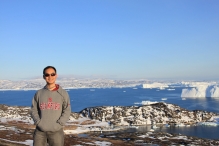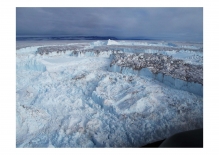CUHK
News Centre
CUHK Researcher Documents Sustained Mass Loss of Northeast Greenland Ice Sheet Triggered by Regional Warming in New Study Published in Nature Climate Change
Prof. LIU Lin, Assistant Professor, Earth System Science Programme of The Chinese University of Hong Kong (CUHK), revealed in a joint research with international scientists that the Northeastern part of Greenland, the last remaining stable portion of Greenland’s ice sheet that has been stable for 25 years, is losing its ice rapidly. In particular, the Zachariae glacier has suffered a very significant retreat of 20 km just over the last decade. The findings have been published recently in Nature Climate Change. Despite the long geographical distance between Hong Kong and Greenland, ice loss from Greenland glaciers directly contribute to global sea level rise and receiving increasing attention from the general public. The future fate of Greenland is uncertain and its mass loss will possibly accelerate, therefore promoting a fast rise in sea level, impacting coastal areas including Hong Kong.
Greenland, the largest island in the world, is located in the Arctic more than 9,000 km away from Hong Kong. Since most of the island’s surface is covered by a massive ice body, Greenland is the single largest contributor to global sea level rise in the past two decades. If all this ice melts, global sea level will rise by as much as 6 metres. Global sea level has been rising at a rate of about 3.2 mm/yr over the past two decades, with Greenland alone contributing about 13%. That ice mass loss from the Greenland Ice Sheet has generally increased over the last decades is well known. The prevalent idea is that dominant contribution to mass loss of the ice sheet is from major outlet glaciers in West and Southeast Greenland. For example, the well-studied Jakobshavn glacier in west Greenland has retreated about 35 km over the last 150 years.
To quantitatively determine the sustained glacier thinning and mass loss, the interdisciplinary team of 13 scientists from 10 institutions (including the lead institution Technical University of Denmark, Stanford University and CUHK) in five countries synthesized a diversity of data acquired using geophysical and remote sensing techniques, including old aerial photographs from 1978, satellite-based altimetry, gravimetry, radar and optical imagery, and meteorological models. Professor Liu’s contribution to this study is primarily to map glacier flow motions from satellite radar images. They found that glacier speeds increased by more than 100 metres per year from 2001 to 2012.
Professor Liu said, ‘The faster a glacier moves, the more ice it carries from Greenland’s interior to the ocean, contributing to global sea level rise. Unlike other large glaciers in Greenland, the Northeast Greenland ice stream reaches directly into the interior of the ice sheet, extending inland by more than 600 km. This implies that changes at the margin can impact the mass balance far in the centre of the ice sheet. Furthermore, the Northeast Greenland ice stream, which covers an area of 16% of the entire ice sheet (corresponding to twice of Jakobshavn Glacier and 320 times of Hong Kong), is so massive that it has the potential to significantly change the total mass balance of the entire Greenland ice sheet in the future. Our study shows that whilst the thinning from 1978 to 2012 was limited, appreciable mass loss was triggered in 2003 and has sustained over the past ten years. The likely cause of the sustained mass loss is a combination of warmer summer air temperatures and sea temperatures.’
Prof. Liu Lin’s participation in this interdisciplinary study was initiated when he was the George Thompson postdoctoral fellow in Stanford University. He is now a faculty member of the Earth System Science Programme in the Faculty of Science at CUHK. Professor Liu is now building an integrated research and education programme to study polar changes in a warming climate, and will collaborate with the newly established Jockey Club Museum of Climate Change to develop a science-based outreach program in Hong Kong, hoping to raise the awareness about climate changes among a broad community in Hong Kong. Liu has been applying state-of-the-art geophysical and remote sensing techniques to address critical scientific questions on polar changes. He has been conducting research projects on glaciers and permafrost in the Arctic. Joining CUHK recently, he is shifting his focus to the glaciers and frozen ground on the Tibet Plateau, the world’s third pole.
CUHK Earth System Science Programme Website: http://www.cuhk.edu.hk/sci/essc/
Citation: ‘Sustained mass loss of the northeast Greenland ice sheet triggered by regional warming’ by Shfaqat A. Khan, Kurt H. Kjær, Michael Bevis, Jonathan L. Bamber, John Wahr, Kristian K. Kjeldsen, Anders A. Bjørk, Niels J. Korsgaard, Leigh A. Stearns, Michiel R. van den Broeke, Lin Liu, Nicolaj K. Larsen & Ioana S. Muresan and published in Nature Climate Change (2014) doi:10.1038/nclimate2161
Prof Liu Lin in Greenland. He is shifting his research focus to the glaciers and frozen ground on the Tibet Plateau, the world’s third pole.







